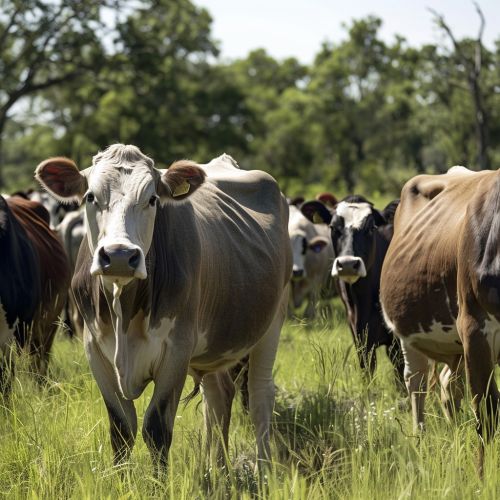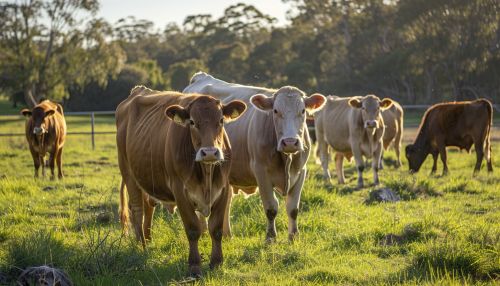Brangus
Introduction
The Brangus is a breed of beef cattle that is a hybrid of the Brahman and Angus breeds. This breed was developed to combine the superior traits of both parent breeds, resulting in cattle that are well-adapted to a variety of environmental conditions, particularly in regions with high temperatures and humidity. The Brangus is known for its hardiness, disease resistance, and high-quality beef production.
History and Development
The development of the Brangus breed began in the early 20th century in the United States. The goal was to create a breed that could thrive in the harsh climatic conditions of the southern states. The American Brangus Breeders Association (ABBA) was established in 1949 to promote and regulate the breed. The breed was developed by crossbreeding Brahman cattle, known for their heat tolerance and disease resistance, with Angus cattle, known for their superior meat quality and maternal traits. The result was a breed that retained the best characteristics of both parent breeds.
Characteristics
Brangus cattle exhibit a blend of physical and genetic traits from both Brahman and Angus cattle. They typically have a solid black or red coat, with a sleek, short-haired appearance. The breed is polled, meaning they naturally do not have horns. Brangus cattle are medium to large in size, with bulls weighing between 1,800 to 2,200 pounds and cows weighing between 1,100 to 1,500 pounds.
Physical Traits
Brangus cattle have a well-muscled body, with a broad back and deep, rounded rib cage. They possess a hump over the shoulders, inherited from the Brahman breed, which is more pronounced in bulls. The skin is loose and pliable, aiding in heat dissipation. Their ears are medium-sized and pendulous, another trait inherited from the Brahman.


Genetic Traits
The genetic composition of Brangus cattle is typically 3/8 Brahman and 5/8 Angus. This specific ratio was chosen to optimize the desirable traits from both breeds. The Brahman genetics contribute to the breed's heat tolerance, disease resistance, and longevity, while the Angus genetics enhance meat quality, fertility, and maternal instincts.
Adaptability
Brangus cattle are highly adaptable to various environmental conditions. They are particularly well-suited to hot, humid climates, making them popular in the southern United States, Central and South America, and Australia. Their loose skin and sweat glands help them regulate body temperature effectively, and their resistance to parasites and diseases makes them a low-maintenance breed.
Reproductive Performance
Brangus cattle are known for their excellent reproductive performance. They reach sexual maturity early and have a high fertility rate. The cows exhibit strong maternal instincts and are known for their ease of calving. The breed's longevity also contributes to their reproductive efficiency, with many cows remaining productive well into their teens.
Beef Quality
The Brangus breed is highly regarded for its beef quality. The meat is well-marbled, tender, and flavorful, characteristics that are highly prized in the beef industry. The Angus genetics contribute significantly to these traits, making Brangus beef comparable to purebred Angus beef in terms of quality. The breed's ability to produce high-quality beef in challenging environmental conditions makes it a valuable asset to the beef industry.
Health and Disease Resistance
One of the most significant advantages of the Brangus breed is its health and disease resistance. The Brahman genetics provide a natural resistance to many common cattle diseases and parasites. This resistance reduces the need for chemical treatments and veterinary interventions, making Brangus cattle a cost-effective choice for producers. Additionally, their hardiness and adaptability contribute to lower mortality rates and improved overall herd health.
Economic Importance
Brangus cattle play a crucial role in the beef industry, particularly in regions with challenging environmental conditions. Their ability to produce high-quality beef with minimal input costs makes them an economically viable option for producers. The breed's adaptability and disease resistance also contribute to its economic importance, as it reduces the need for costly interventions and increases overall productivity.
Global Distribution
The Brangus breed has gained popularity worldwide, with significant populations in the United States, Central and South America, Australia, and parts of Africa. The breed's adaptability to various climates and its superior beef quality have contributed to its global spread. International Brangus associations and breeding programs continue to promote and develop the breed, ensuring its continued success and expansion.
Breeding Programs and Associations
Several breeding programs and associations are dedicated to the promotion and development of the Brangus breed. The American Brangus Breeders Association (ABBA) is the primary organization in the United States, providing registration, genetic evaluation, and promotional services. International associations, such as the Australian Brangus Cattle Association and the Brangus Breeders International, also play a significant role in the breed's development and promotion.
Future Prospects
The future of the Brangus breed looks promising, with ongoing efforts to enhance its genetic traits and adaptability. Advances in genetic engineering and biotechnology offer new opportunities for improving the breed's performance and disease resistance. Additionally, the increasing demand for high-quality beef in global markets ensures that the Brangus breed will continue to be a valuable asset to the beef industry.
